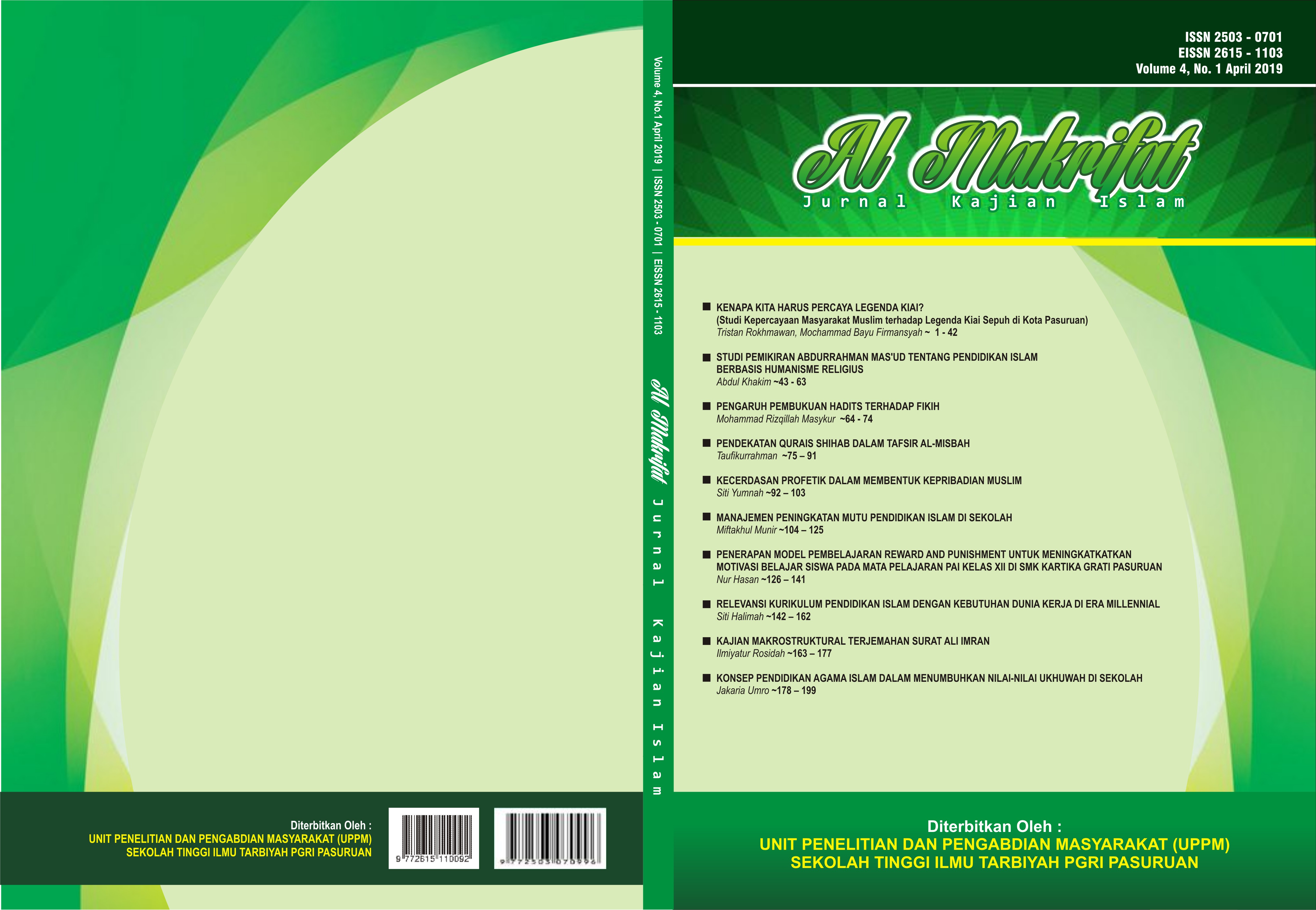Kenapa Kita Harus Percaya Legenda Kiai? (Studi Kepercayaan Masyarakat Muslim terhadap Legenda Kiai Sepuh di Kota Pasuruan)
Keywords:
community beliefs, religious legend, Muslim community
Abstract
Jan Harold Brunyand divides three types of legends based on the subject of the story: religious legends, supernatural legends, individual legends and place legends. Muslim communities in the city of Pasuruan have many types of religious legends. The religious legend contains stories of legend with the subject of the story: people in the past who were considered holy, godly, or people who fought to preach religion. The community of Pasuruan conveyed oral literature in the form of religious legends through the ritual of 'haul', which is a religious activity intended to pray for a person or religious figure who has died. In the ritual of 'haul', religious legends with the subject of a pious person (Kiai or Mbah) are read orally in the form of reading 'manakib'. The uniqueness of the religious legends about ulama, Kiai, or Mbah are the themes of the stories that were conceived. Most of the contents of the story are about the supernatural powers of the characters. Muslim communities believe the stories and images presented in this legend, although they cannot be accepted with reason or logic in general. In this study researchers found that this belief has a special function in order to maintain religious values ​​in the Muslim community in the city of Pasuruan. The author concludes that two forms of belief in religious legends include (1) beliefs built by Muslim communities collectively as a form of interpretation of various phenomena outside their logic of reasoning and 2) beliefs built by Muslim societies as regulators of social institutions and norms, and to internalize collectively valid norms. In addition, this legend also functions as (1) a tool for the development and preservation of local culture around legendary area sites, 2) a tool for determining the normative order of local Muslim communities around the site, and 3) tools for certain groups that have special interests or relationships with the subject of the story and the site.References
Bascom, W. (1954). Four Function of Folklore. The Journal of American Folklore, 333-349.
Bascom, W. (1965). The Form of Folklore : Prose Narrative. The Journal of American Folklore, Vol. 78, No. 307 , 3-20.
Dananjaja, J. (2002). Folklore Indonesia : Ilmu Gosip, Dongeng, dan Lain-lain. Jakarta: Pustaka Utama Grafiti.
Haviland, W. A. (1985). Antropologi. Jakarta: Erlangga.
Lantini, E. S. (1996). Refleksi Nilai-nilai Budaya Jawa Dalam Serat Suryaraja. Jakarta: Depdikbud.
Peursen, C. A. (1988). Strategi Kebudayaan. Yogyakarta: Kanisius.
Romas, C. S. (2013). Kekerasan di Kerajaan Surgawi. Yogyakarta: LKPM.
Santayana, G. (-, -). Ancient Myth, Religion, and Philosophy. Retrieved Februari 2, 2016, from www.centerforfutureconsciousness.com: http://www.centerforfutureconsciousness.com/pdf_files/Readings/AncientMythPhil.pdf
Sarapik, V. (2000). Artist and Myth. Electronic Journal of Folklore (Folklore Vol. 15) by the Folk Belief and Media Group of ELM .
Soedjijono. (2002). Legenda Pulau Bawean (Kajian dengan Pendekatan Arketipal). Prosiding Seminar Akademik, (p. Volume 2).
Spradley, J. P. (1997). Metode Etnografi. Yogyakarta: Tiara Wacana.
Wellek, R., & Warren, A. (1990). Teori Kesusastraan. Jakarta: Gramedia.
SUMBER LAIN
David, D., Lynn, S. J., & Ellis, A. (2009). Rational and Irrational Beliefs: Research, Theory, and Clinical Practice. Oxford University Pers.
Dharmojo. (1998). Sastra Lisan Ekagi. Jakarta: Pusat Pembinaan dan Pengembangan Bahasa Departemen P & K.
Geertz,Clifford. (1960). The Religion of Java. Chicago: The University of Chicago
Geertz, Clifford. (1971). Islam Observed : Religious Development in Morroco and Indonesia. Chicago & London : The University of Chicago Press.
Geertz,Clifford. (1981). Abangan, Santri, Priyayi Dalam Masyarakat Jawa.Terjemahan oleh Aswab Mahasin. Jakarta: Pustaka Jaya.
Bascom, W. (1965). The Form of Folklore : Prose Narrative. The Journal of American Folklore, Vol. 78, No. 307 , 3-20.
Dananjaja, J. (2002). Folklore Indonesia : Ilmu Gosip, Dongeng, dan Lain-lain. Jakarta: Pustaka Utama Grafiti.
Haviland, W. A. (1985). Antropologi. Jakarta: Erlangga.
Lantini, E. S. (1996). Refleksi Nilai-nilai Budaya Jawa Dalam Serat Suryaraja. Jakarta: Depdikbud.
Peursen, C. A. (1988). Strategi Kebudayaan. Yogyakarta: Kanisius.
Romas, C. S. (2013). Kekerasan di Kerajaan Surgawi. Yogyakarta: LKPM.
Santayana, G. (-, -). Ancient Myth, Religion, and Philosophy. Retrieved Februari 2, 2016, from www.centerforfutureconsciousness.com: http://www.centerforfutureconsciousness.com/pdf_files/Readings/AncientMythPhil.pdf
Sarapik, V. (2000). Artist and Myth. Electronic Journal of Folklore (Folklore Vol. 15) by the Folk Belief and Media Group of ELM .
Soedjijono. (2002). Legenda Pulau Bawean (Kajian dengan Pendekatan Arketipal). Prosiding Seminar Akademik, (p. Volume 2).
Spradley, J. P. (1997). Metode Etnografi. Yogyakarta: Tiara Wacana.
Wellek, R., & Warren, A. (1990). Teori Kesusastraan. Jakarta: Gramedia.
SUMBER LAIN
David, D., Lynn, S. J., & Ellis, A. (2009). Rational and Irrational Beliefs: Research, Theory, and Clinical Practice. Oxford University Pers.
Dharmojo. (1998). Sastra Lisan Ekagi. Jakarta: Pusat Pembinaan dan Pengembangan Bahasa Departemen P & K.
Geertz,Clifford. (1960). The Religion of Java. Chicago: The University of Chicago
Geertz, Clifford. (1971). Islam Observed : Religious Development in Morroco and Indonesia. Chicago & London : The University of Chicago Press.
Geertz,Clifford. (1981). Abangan, Santri, Priyayi Dalam Masyarakat Jawa.Terjemahan oleh Aswab Mahasin. Jakarta: Pustaka Jaya.
Published
2019-03-28
How to Cite
Mochammad Bayu Firmansyah, T. R. ,. (2019). Kenapa Kita Harus Percaya Legenda Kiai? (Studi Kepercayaan Masyarakat Muslim terhadap Legenda Kiai Sepuh di Kota Pasuruan). Al-Makrifat: Jurnal Kajian Islam, 4(1), 1-42. Retrieved from https://ejournal.kopertais4.or.id/tapalkuda/index.php/makrifat/article/view/3297
Section
Articles

